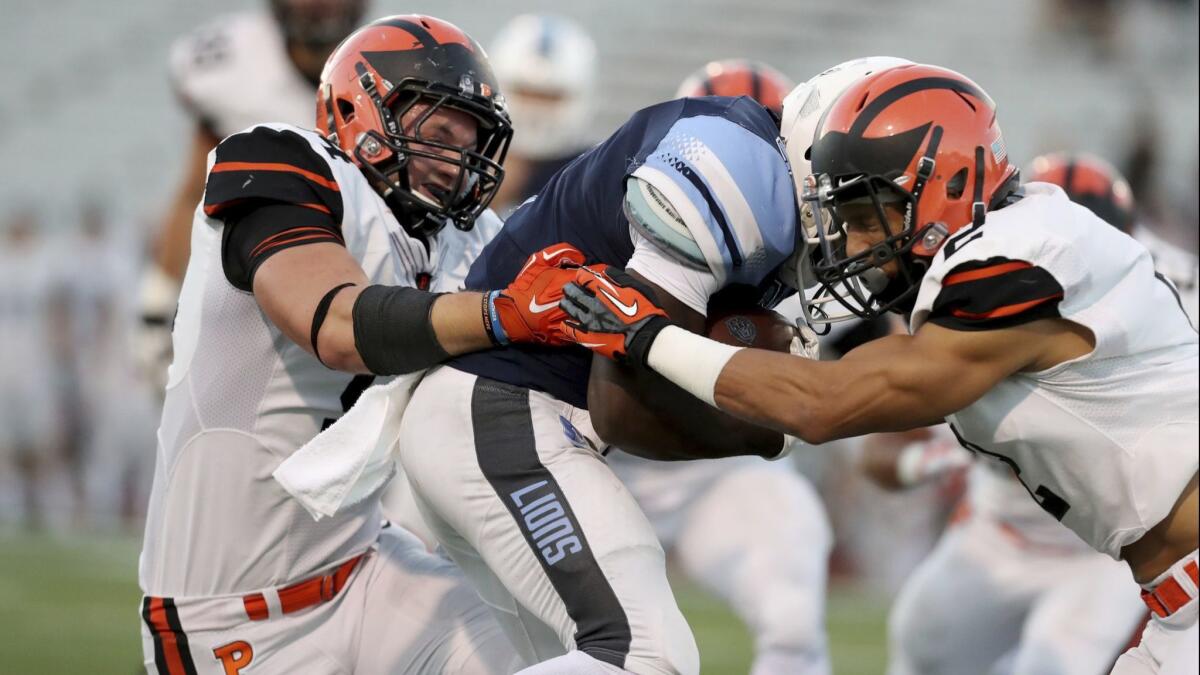After a small change in kickoff rules, Ivy League football players saw a big drop in concussions

- Share via
In the Ivy League, not all experiments occur in research laboratories. Some occur on the gridiron.
Since 2016, the league’s eight football teams have been testing a rule change designed to reduce concussions. And according to a study published Monday in the Journal of the American Medical Assn., it seems to be working.
The new rule applies to kickoffs. The kick itself is safe, but once the ball is caught, players on both teams speed across the field toward their opponents. By the time they finally meet, they’ve built up so much momentum that the risk of a concussion-inducing impact is disproportionately high.
In the 2015 season, for instance, only 6% of the plays in Ivy League games were kickoffs, but they were responsible for 21% of the league’s concussions.
The coaches for the eight private universities thought they had a solution: Move the kickoff line forward from the 35-yard line to the 40-yard line so that more kicks land in the end zone, where players have the option of downing the ball for a touchback. That automatically places the ball on the 20-yard line without the need for any blocks or tackles.
A group from the Ivy League conference and two of its member schools (the University of Pennsylvania and Princeton) examined two seasons’ worth of games to see if the rule change was having its intended effect.
Led by Douglas Wiebe, an epidemiologist who directs the Penn Injury Science Center, the researchers gathered data on all regular-season, in-conference football games played in the years 2013 through 2017.
Sure enough, touchbacks became more popular after the rule change went into effect. In the 2013, 2014 and 2015 seasons, an average of 17.9% of kickoffs resulted in touchbacks. But in the 2016 and 2017 seasons, that average surged to 48%.
This increase came in spite of the fact that when the kickoff line moved 5 yards down the field, the touchback line did as well. There had been some concern that shaving 5 yards off the starting field position would make players more inclined to run after catching the ball in the end zone. If so, the rule change could have backfired; the data suggest it didn’t.
Encouraging more touchbacks wasn’t the ultimate goal, of course — reducing concussions was. So the researchers calculated the rate of concussions per 1,000 kickoffs both before and after the rule change.
In the first three seasons, there were 2,379 kickoff plays throughout the regular-season Ivy League conference games. During those plays, athletes suffered 26 concussions. That worked out to 10.9 concussions per 1,000 kickoffs.
In the last two seasons, there were 1,467 kickoff plays, during which athletes suffered three concussions. That amounted to a rate of 2.04 concussions per 1,000 kickoffs.
In other words, there were about nine fewer concussions per 1,000 kickoffs after the rule was changed. Wiebe and his colleagues determined that the difference was far too large to be due to chance.
But that didn’t mean moving the kickoff line deserved all the credit. Another rule change in 2016 put an end to full-contact hitting during practices. It’s possible this played a role as well, though the researchers were doubtful that it would affect kickoff plays more than all other types of plays. Or there could be something else going on that was making the game safer overall.
To find out, the researchers calculated concussion rates for all non-kickoff parts of the game. In the first three seasons, there were 100 concussions over the course of 39,107 plays. In the last two seasons, there were 30 concussions over 25,526 plays. That meant the rate fell from 2.56 to 1.18 concussions per 1,000 non-kickoff plays, a drop of 1.38 concussions per 1,000 such plays.
Then Wiebe and his colleagues used the “difference-in-difference” statistical method to compare the change in kickoff plays with the change in the rest of the plays. They calculated that the new kickoff rule was associated with safer football games — for every 1,000 kickoffs, 7.5 players were spared concussions after the rule went into effect.
The study authors cautioned that their results might not apply to other Division 1 teams in the National Collegiate Athletic Assn., let alone professional teams in the National Football League.
But as the NCAA contemplates a nationwide adjustment to kickoff rules, these findings demonstrate that “targeted policy changes can reduce sport-related concussion,” the researchers concluded.
Follow me on Twitter @LATkarenkaplan and “like” Los Angeles Times Science & Health on Facebook.







